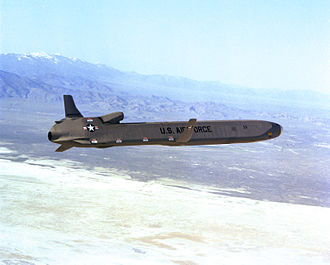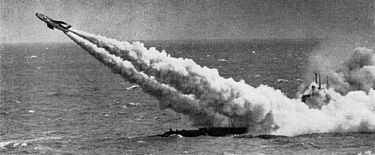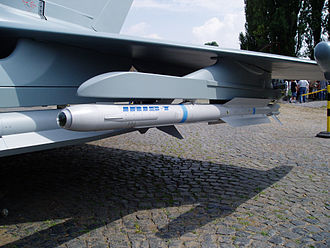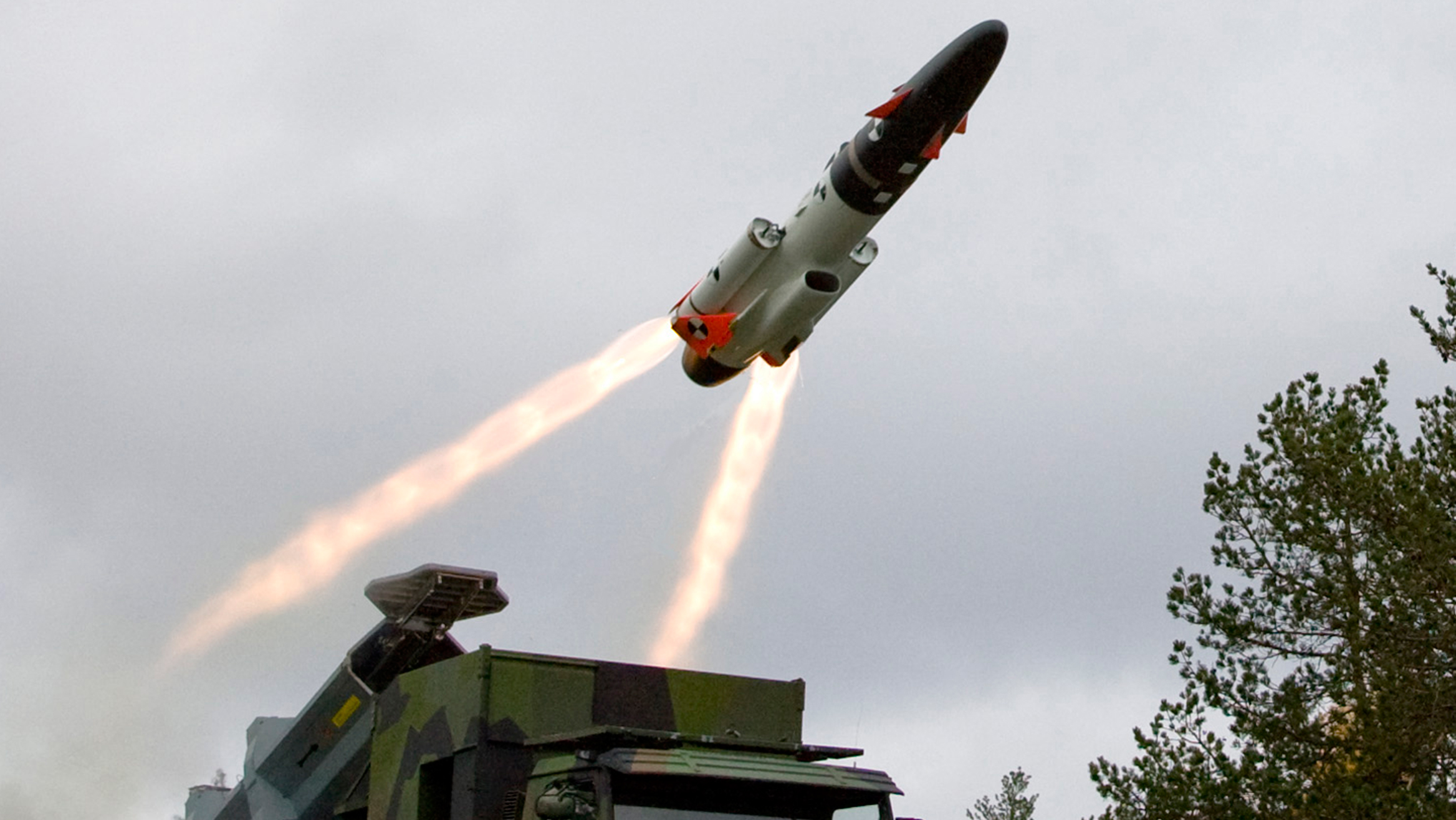


An air-to-air missile (AAM) is a missile fired from an aircraft for the purpose of destroying another aircraft. AAMs are typically powered by one or more rocket motors, usually solid fueled but sometimes liquid fueled. Ramjet engines, as used on the Meteor (missile) are emerging as propulsion that will enable future medium-range missiles to maintain higher average speed across their engagement envelope.
Air-to-air missiles are broadly put in two groups. Those designed to engage opposing aircraft at ranges of less than 30 km are known as short-range or "within visual range" missiles (SRAAMs or WVRAAMs) and are sometimes called "dogfight" missiles because they are designed to optimize their agility rather than range. Most use infrared guidance and are called heat-seeking missiles. In contrast, medium- or long-range missiles (MRAAMs or LRAAMs), which both fall under the category of beyond visual range missiles (BVRAAMs), tend to rely upon radar guidance, of which there are many forms. Some modern ones use inertial guidance and/or "mid-course updates" to get the missile close enough to use an active homing sensor. The concepts of air-to-air missiles and surface-to-air missiles are very closely related, and in some cases versions of the same weapon may be used for both roles, such as the ASRAAM and Sea Ceptor.

An air-to-surface missile (ASM) or air-to-ground missile (AGM) is a missile designed to be launched from military aircraft at targets on land or sea. There are also unpowered guided glide bombs not considered missiles. The two most common propulsion systems for air-to-surface missiles are rocket motors, usually with shorter range, and slower, longer-range jet engines. Some Soviet-designed air-to-surface missiles are powered by ramjets, giving them both long range and high speed.
Guidance for air-to-surface missiles is typically via laser guidance, infrared guidance, optical guidance or via satellite guidance signals. The type of guidance depends on the type of target. Ships, for example, may be detected via passive radar or active radar homing, less effective against multiple, small, fast-moving land targets.
There is some cross-over between air-to-surface missiles and surface-to-surface missiles. For example, there was an air-launched version of the Tomahawk missile, superseded by the AGM-86 ALCM. Other missiles used in both roles include the Penguin and AGM-84 Harpoon anti-ship missiles. Many air-to-surface missiles can be used against both ships and land targets, although some must be modified to perform a different role; for example, the AGM-84E Standoff Land Attack Missile is a land-attack version of the Harpoon.
A major advantage of air-to-surface missiles for ground attack by aircraft is the standoff distance they provide: missiles can be launched from a distance without coming within range of the target's air defences. Most air-to-surface missiles are fire-and-forget from a standoff distance, allowing the attacker to withdraw without approaching further after launch. Some missiles (typically cruise missiles or anti-ship missiles) have long enough range to be launched over the horizon, finding the target autonomously.
Typically, the higher and faster the launching aircraft is flying, the longer the reach of a particular missile is. For long-range missiles this difference can be relatively small, but short-range missiles (like the AGM-65 Maverick) have a much longer range when launched at altitude.
There have been examples of air-launched ballistic missiles (Air Launched ICBM), but they are rare. Sometimes air-to-surface missiles are divided into the categories of tactical and strategic. Typically missiles with chemical explosive or small nuclear warheads are classed as tactical, and large nuclear warheads as strategic.

A surface-to-air missile (SAM), or ground-to-air missile (GTAM /ˈdʒiːtæm/), is a missile designed to be launched from the ground to destroy aircraft or other missiles. It is one type of antiaircraft system; in modern armed forces, missiles have replaced most other forms of dedicated antiaircraft weapons, with anti-aircraft guns pushed into specialized roles. Examples for ground and naval air missiles are the Raytheon Standard Missile 2, Raytheon Standard Missile 6 at Arleigh Burke-class destroyer of the United States Navy, or the MBDA Aster Missile at ships of the british Royal Navy like the Type 45 destroyer and ships of the French Navy like the Horizon-class frigate.
The first serious attempts at SAM development took place during World War II, although no operational systems were introduced. Further development in the 1940s and 1950s led to the first operational systems being introduced by most major forces during the second half of the 1950s. Smaller systems, suitable for close-range work, evolved through the 1960s and 1970s, to modern systems that are man-portable. Shipborne systems followed the evolution of land-based models, starting with long-range weapons and steadily evolving toward smaller designs to provide a layered defence that have pushed gun-based systems into the shortest-range roles. The American Nike Ajax was the first operational guided missile SAM system, and the Soviet Union's S-75 Dvina was the most-produced SAM. Widely used modern examples include the Patriot and S-300 wide-area systems, SM-6 naval missiles, and short-range man-portable systems like the Stinger and Strela-3.

A surface-to-surface missile (SSM) or ground-to-ground missile (GGM) is a missile designed to be launched from the ground or the sea and strike targets on land or at sea. They may be fired from hand-held or vehicle mounted devices, from fixed installations, or from a ship. They are often powered by a rocket engine or sometimes fired by an explosive charge, since the launching platform is typically stationary or moving slowly. They usually have fins and/or wings for lift and stability, although hyper-velocity or short-ranged missiles may use body lift or fly a ballistic trajectory. The V-1 flying bomb was the first operational surface-to-surface missile.
Contemporary surface-to-surface missiles are usually guided. An unguided surface-to-surface missile is usually referred to as a rocket (for example, an RPG-7 or M72 LAW is an anti-tank rocket whereas a BGM-71 TOW or AT-2 Swatter is an anti-tank guided missile). Examples of surface-to-surface missile include the MGM-140 ATACMS, the Ground-Launched Small Diameter Bomb (GLSDB)[1][2][3] and the Long Range Precision Fires (LRPF).[4][5][6]
An air-launched cruise missile (ALCM) is a cruise missile that is launched from a military aircraft. Current versions are typically standoff weapons which are used to attack predetermined land targets with conventional, nuclear or thermonuclear payloads. The Ground Launched Cruise Missile, or GLCM, (officially designated BGM-109G Gryphon) was a ground-launched cruise missile developed by the United States Air Force in the last decade of the Cold War and destroyed under the INF Treaty.
A submarine-launched cruise missile (SLCM) is a cruise missile that is launched from a submarine (especially a SSG or SSGN). Current versions are typically standoff weapons known as land-attack cruise missiles (LACMs), which are used to attack predetermined land targets with conventional or nuclear payloads. Anti-ship cruise missiles (ASCMs) are also used, and some submarine-launched cruise missiles have variants for both functions.

